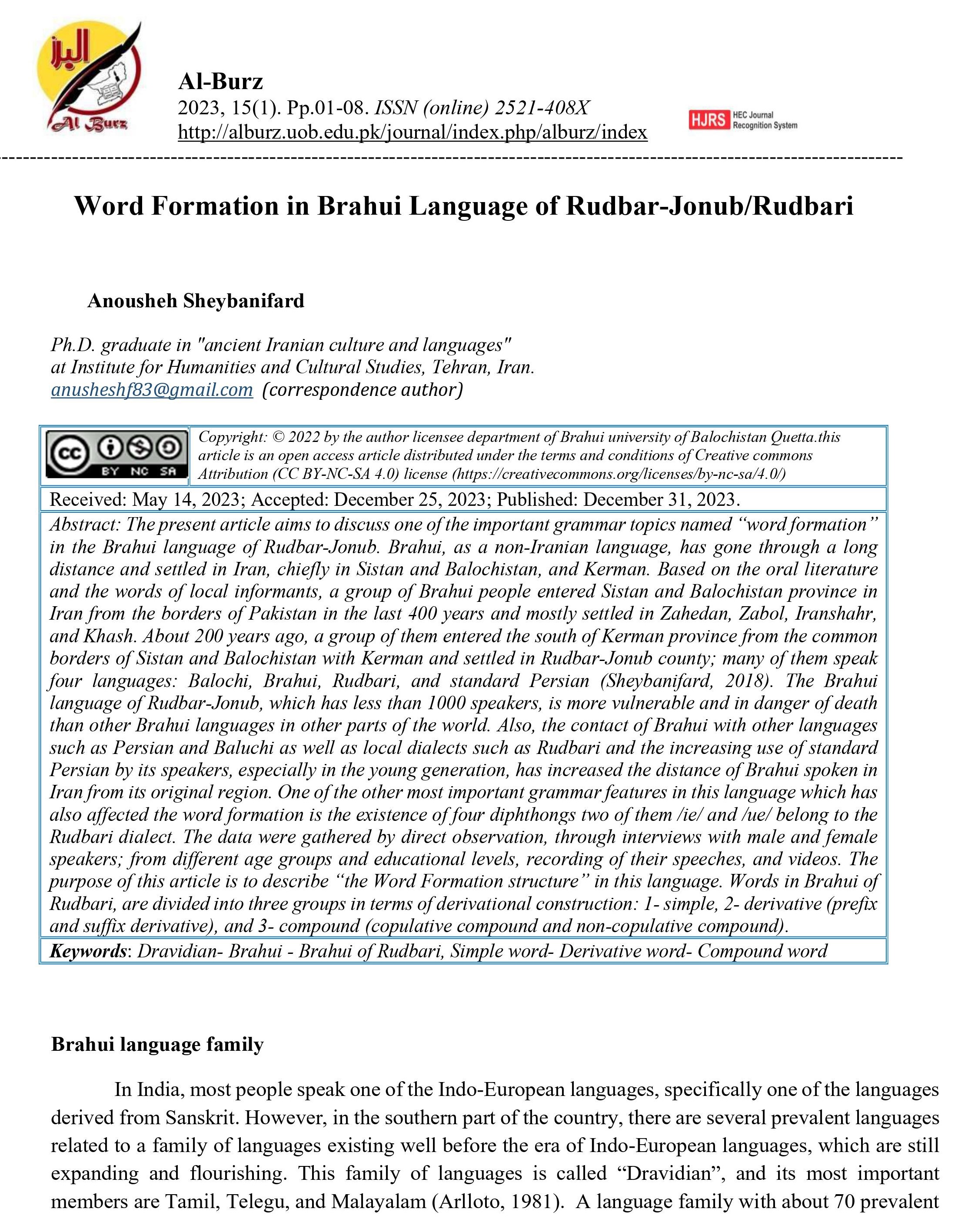Word Formation in Brahui Language of Rudbar-Jonub/Rudbari
DOI:
https://doi.org/10.54781/abz.v15i01.396Keywords:
Dravidian- Brahui - Brahui of Rudbari, Simple word- Derivative word- Compound wordAbstract
The present article aims to discuss one of the important grammar topics named “word formation” in the Brahui language of Rudbar-Jonub. Brahui, as a non-Iranian language, has gone through a long distance and settled in Iran, chiefly in Sistan and Balochistan, and Kerman. Based on the oral literature and the words of local informants, a group of Brahui people entered Sistan and Balochistan province in Iran from the borders of Pakistan in the last 400 years and mostly settled in Zahedan, Zabol, Iranshahr, and Khash. About 200 years ago, a group of them entered the south of Kerman province from the common borders of Sistan and Balochistan with Kerman and settled in Rudbar-Jonub county; many of them speak four languages: Balochi, Brahui, Rudbari, and standard Persian (Sheybanifard, 2018). The Brahui language of Rudbar-Jonub, which has less than 1000 speakers, is more vulnerable and in danger of death than other Brahui languages in other parts of the world. Also, the contact of Brahui with other languages such as Persian and Baluchi as well as local dialects such as Rudbari and the increasing use of standard Persian by its speakers, especially in the young generation, has increased the distance of Brahui spoken in Iran from its original region. One of the other most important grammar features in this language which has also affected the word formation is the existence of four diphthongs two of them /ie/ and /ue/ belong to the Rudbari dialect. The data were gathered by direct observation, through interviews with male and female speakers; from different age groups and educational levels, recording of their speeches, and videos. The purpose of this article is to describe “the Word Formation structure” in this language. Words in Brahui of Rudbari, are divided into three groups in terms of derivational construction: 1- simple, 2- derivative (prefix and suffix derivative), and 3- compound (copulative compound and non-copulative compound).
References
Abolghasemi, Mohsen. 2002. Historical grammar of the Persian language. Tehran: Samt.
Arlotto, Anthony. 1939. Introduction to historical linguistics. New York: Washington, D.C.: University Press of America, Houghton Mifflin.
Andronov, Mikhail S. 1980. The Brahui Language. Moscow.
Bashir, Elena. 2003. Brahui-Notes. South Asian Language Resource Center Workshop on Languages of Afghanistan and neighboring areas.
Bray, Dennis. 1909. The Brahui Language. Vol. 1: Introduction and Grammar. Calcutta.
Dr. Liaquat Ali Sani, Dr. Yousaf Ali Rodeni, & Muneer Ahmed Hanfi. (2022). ENGLISH: Spelling Issues of Brahui Language; Causes and Suggestions. Al-Dalili, 4(1), 01–11. Retrieved from https://www.aldalili.com/index.php/dalili/article/view/73
Elfenbein, Josef. 1986. Brahui. New York: Columbia University: Encyclopedia Iranica.
Ethnologue. The Language of the World: Brahui.
Motallebi, Mohammad, and Sheybanifard, Anoushe (Fatemeh). 2013. Some historical phonology of the Rudbari dialect of Kerman. Kerman: Literature and language.
Pagani, L., Colonna, V., Tyler-Smith, C., Ayub, A. 2017. Ethnolinguistic and Genetic Perspective on the Origins of the Dravidian-Speaking Brahui in Pakistan. Man India; 97(1): 267–278.
Sediqqi-nejad, sepehr and Motallebi, Mohammad. 2018. A Diachronic Study of Three Idiosyncratic Pair-sounds in Qaleganji Variant of Rudbari (Kerman). Gilan University: Persian Language and Iranian Dialects.
Sheybanifard, Anoushe (Fatemeh). 2018. A Structural Description of Barahui variety of South Rudbar and its comparison with Rudbari dialect, P.h.D theses. Tehran: Institute for Humanities and Cultural Studies.

Downloads
Published
How to Cite
License
Copyright (c) 2023 Anoushe Sheybanifard

This work is licensed under a Creative Commons Attribution-NonCommercial-ShareAlike 4.0 International License.
Alburz has licensed under a CC Attribution-NonCommercial-ShareAlike 4.0



